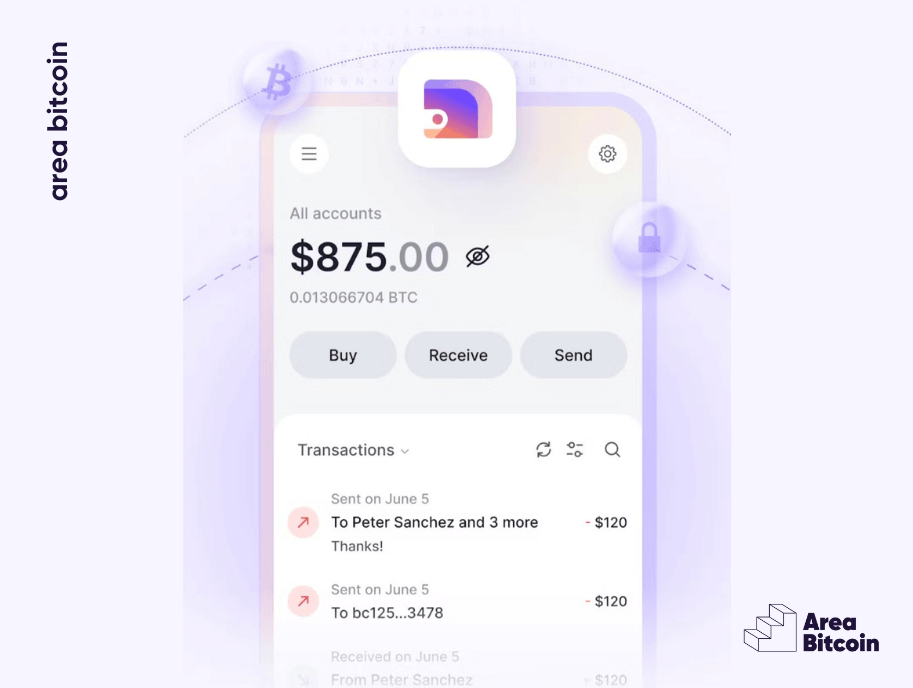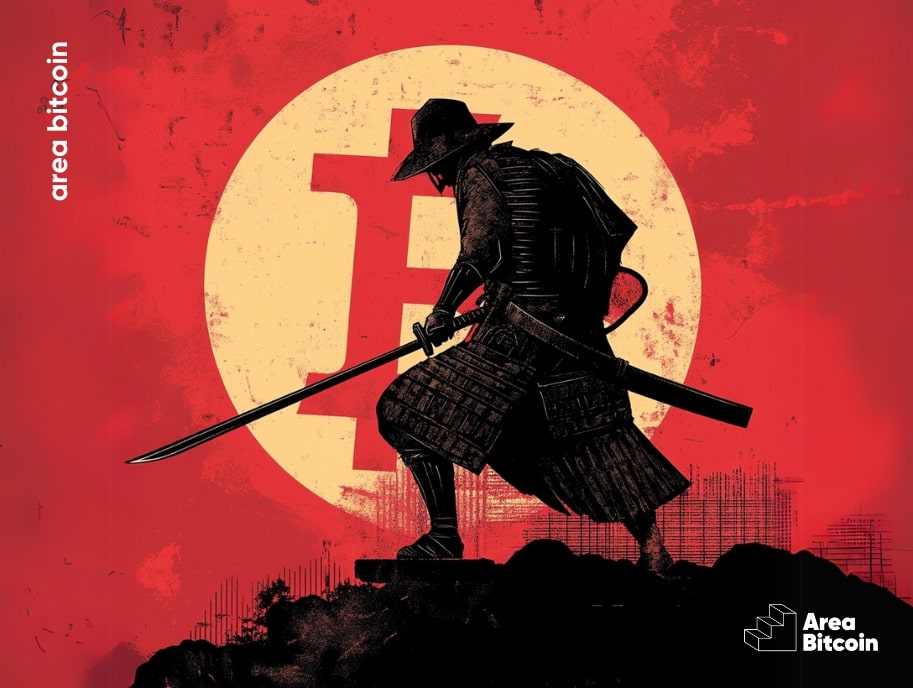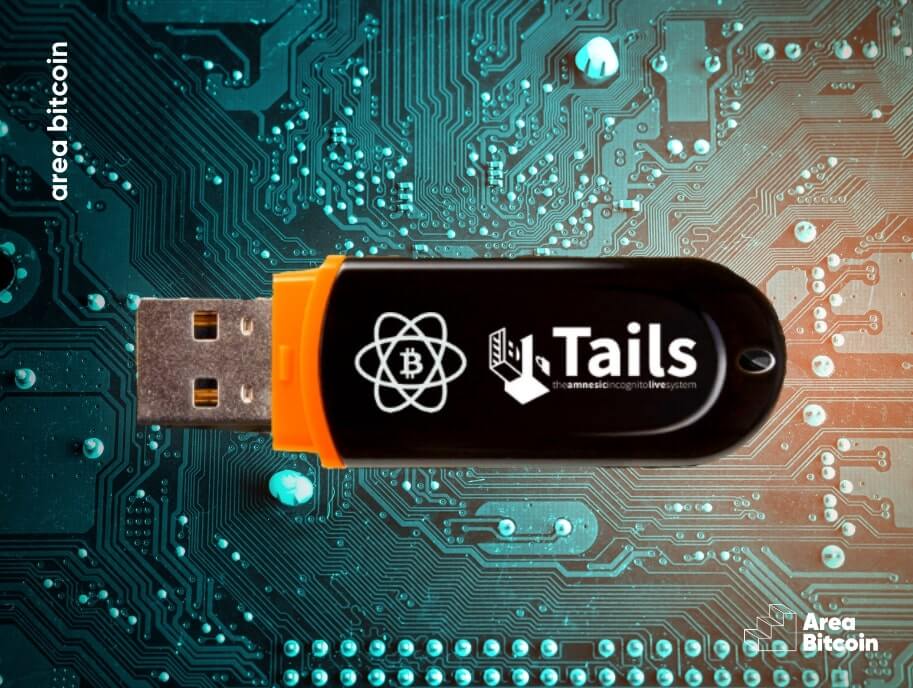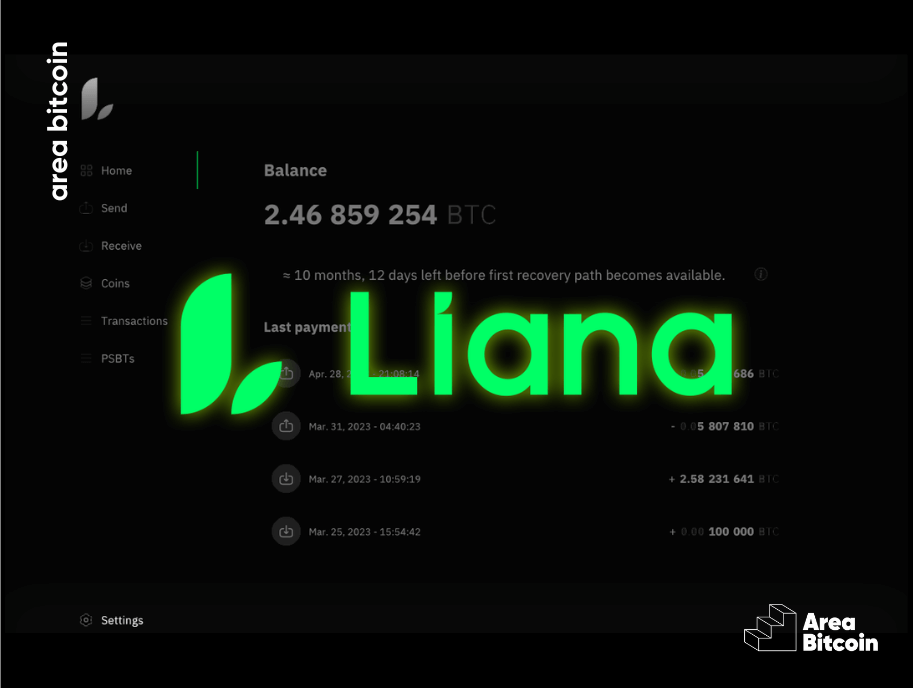Bitcoin has fundamentally changed the way we understand and handle money, and at the heart of this revolution are Bitcoin wallets, which are essential tools that allow us to interact with the network to use and store Bitcoin securely.
Within this area, one of the most intriguing innovations and, for some, counter-intuitive, is the “paper wallet“.
In a world dominated by digitization and online interconnection, it may seem like an anachronism to store Bitcoin in a medium as tangible and fragile as paper. However, this choice has one central reason: security.
In this article, you will understand what paper wallets are, how they work, how to create yours, and whether it is worth having this type of wallet nowadays.
Come on!
What is a Bitcoin Wallet, and Why is it So Crucial?
In simple terms, a Bitcoin wallet stores the private keys needed to access, move, and sign transactions from your Bitcoin balance.
It operates through encrypted codes: public keys and private keys. The public key acts as a blockchain address, allowing others to send Bitcoin to you. The private key, on the other hand, ensures that you are the legitimate owner of your wallet and is vital to moving your balances.
To enhance the user experience, these codes are often transformed into QR codes, allowing easy transactions through a simple scan. This makes it possible to send and receive Bitcoin (and other currencies) freely and globally.
What is especially revolutionary about Bitcoin is that it eliminates the need for intermediaries.
With a Bitcoin wallet, you have full control over your money. There is no customer support or bank managers to intervene; the responsibility rests entirely on you.
And as the saying goes, “With great powers come great responsibilities”. If you want the sovereignty that Bitcoin offers, you must be ready to take that responsibility.
There are various forms of Bitcoin wallets:
- Computer software,
- Mobile apps,
- Physical devices similar to flash drives,
- Paper wallets with printed codes,
- Or even a set of words you memorize.
Although different in format, they all have the same goal: to securely store private keys, ensuring that you maintain autonomy over your money, without relying on third parties.
To contextualize, imagine a Bitcoin wallet as a digital bank account. However, instead of a bank holding control over your money, with a Bitcoin wallet, you have full control. And best of all, being digital, portable, and global, you can use your Bitcoin wallet anywhere in the world.
Now that you already know what a Bitcoin wallet is, let’s delve specifically into the paper wallet.
What is a Paper Wallet?
A Bitcoin paper wallet is, in essence, a form of offline storage for your Bitcoin. It is a physical document that contains both the public key and the private key.
- Public Key: This is basically your Bitcoin “address”. It’s like a bank account number. When someone wants to send you Bitcoin, that’s the information you provide to the other party.
- Private Key: Think of it as your bank account password. It is a secret string of characters that allows you to access and spend the Bitcoins stored in your wallet. No one but you should know this key.

Characteristics of paper wallets:
- Offline Storage (Cold Storage): The most prominent feature of a paper wallet is that it serves as a form of cold storage. This means that the private keys stored in the wallet never touch the internet, making them immune to online hacks.
- Physical Form: As the name suggests, a paper wallet is typically a physical document, although there are also variations made of metal or other durable materials.
- Public and Private Keys: A paper wallet has both a public (the address to which someone can send cryptocurrencies) and a private key (the “password” that allows access and spending of the stored cryptocurrencies).
- Simplicity: They don’t require electricity, software updates, or specialized infrastructure. Just generate, print, and store.
- Minimal or No Cost: Setting up a paper wallet is typically free or very cheap, especially compared to hardware devices.
- Irrecoverable if Lost: If you lose your paper wallet and lack a backup, there’s no way to recover the stored funds.
- QR Codes: Many paper wallets feature QR codes for both public and private keys, making it easier to scan and access addresses rather than manually typing out long sequences.
Are Paper Wallets Safe?
Security is the main appeal of paper wallets. Since the private key has never been exposed to an online environment, it is almost impossible for hackers or malware to steal it unless they have physical access to the paper itself and decrypt it (if it is encrypted).
However, this method also has vulnerabilities that should be considered. If the physical document is lost, destroyed, or damaged and there are no backup copies, the Bitcoin stored in it can be lost forever.
Another factor is that, despite being considered a cold wallet, which keeps balances offline, you need to trust third parties when creating this wallet, which ends up bringing huge risks to those who want to keep larger balances in Bitcoin for the long term.
We’ll talk about that later.
How to Generate a Paper Wallet?
There are a few websites that allow you to generate keys randomly to create your paper wallet at home.
Using these services typically involves:
- Visiting the website.
- Often, the site asks you to move the cursor or input random characters to ensure key randomness.
- The site then produces a new set of public and private keys.
- You can then print this page, which often includes QR codes for easier transactions.
That said, the best-known sites for you to generate a Bitcoin paper wallet are:
Bitaddress.org
Bitaddress.org is one of the earliest and most popular services, launched anonymously in 2011 by Peter Kroll. It offers a straightforward interface for key generation.
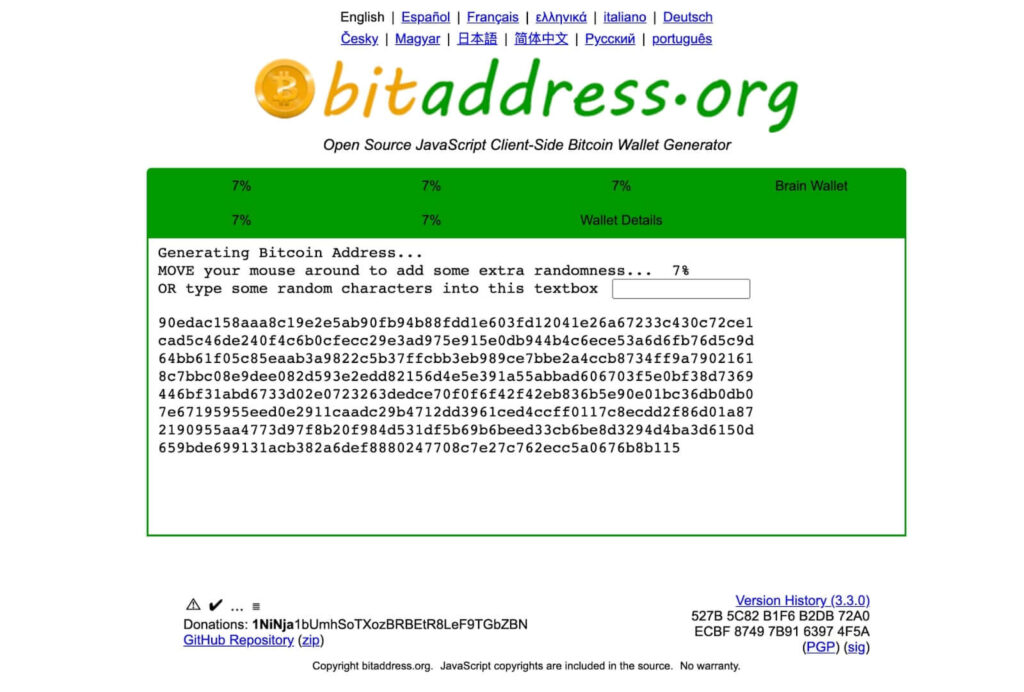
WalletGenerator.net
Similar to Bitaddress.org, WalletGenerator.net supports Bitcoin and other digital currencies, allowing users to generate paper wallets for various coin types.
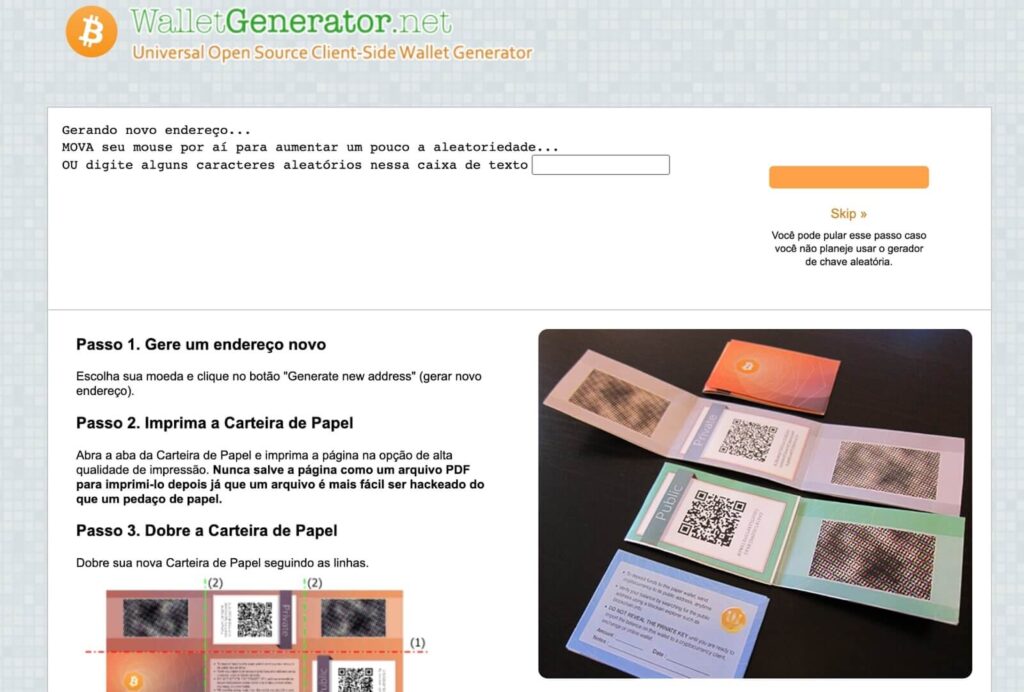
Stay tuned when generating your paper wallet:
- Always generate paper wallets offline: Download the website or tool and run it on a computer that is offline. This ensures that your private keys are never exposed to the internet.
- Use a clean operating system: If possible, use a dedicated computer or a live operating system (such as a bootable USB) that has never been exposed to the internet.
- Verify authenticity: Make sure you are using a genuine website or service and not a malicious copy. A quick search can help confirm the authenticity of the chosen service.
- Some paper wallet generators offer the option to save public and private keys to your computer in PDF format. This is strongly discouraged because a PDF is constantly exposed to online threats. Similarly, images or digital scans of your wallets should be avoided to prevent hackers from detecting them.
- To better protect your paper wallet, one idea is to laminate, but do it at home so that no one sees your private key.
How to Use a Paper Wallet?
After generating your wallet, you will probably want to know how to use it in practice to add funds and spend them, right?
So let’s understand how it works!
Receiving Bitcoin
To add funds to your paper wallet, you can share the public key (or scan the corresponding QR code) with someone or send bitcoin from a digital wallet or exchange to that public key.
There’s no limit to the amount you can add to your paper wallet, nor is there an expiry for the balance.
Spending or Transferring Bitcoin
To spend or transfer Bitcoin from your paper wallet, you’ll need to:
- Import (or “sweep”) your private key into a digital/software wallet, like the mobile-based Blue Wallet. Enter your private key, marking the paper wallet’s first internet exposure, compromising its previously offline security.
- Execute the transaction from this wallet.
Safety note: Once you’ve “swept” your paper wallet, it’s good practice to transfer all funds and dispose of it, resorting to a new one for future storage.
So, unlike depositing into your paper wallet, where only the public key is used, withdrawing from it requires exposing the private key, a crucial step. For this reason, consider paper wallets for single-use, long-term storage, using them once, then replacing them.
Considerations on Paper Wallet Transactions
When you spend only a portion of funds from a paper wallet, the remaining amount is sent to a “change” address. If you haven’t set up this change address before making a transaction, your leftover funds could be lost.
This is because when a Bitcoin transaction is conducted, the entire wallet balance is sent to the blockchain for the network’s supply accounting.
The transaction’s change then returns in the form of an unspent transaction (UTXO). During this change return, wallets typically switch the address for security and privacy reasons.
However, paper wallets don’t do this automatically because they can’t create a change address.
To visualize this, imagine using a $50 bill to buy a $5 cup of coffee. You hand over the $50 and expect $45 in change. That $45 is still yours, but you can only access it once the cashier finishes the transaction and returns it. If both of you suddenly forget the ongoing transaction, it never completes. This is a simple analogy to describe the process.
Manually creating a change address is also possible, but not everyone has the technical know-how, and this method is prone to human errors.
In short, if you decide to use a paper wallet, you should transfer your entire balance to another address, such as a mobile wallet, before sending a partial transaction to a recipient. This is one reason why other wallet alternatives are favored over paper wallets.
“Sweeping” vs. “Importing” Keys
When you import a key from your paper wallet to another wallet, you’re simply copying it. If you decide to spend some of those funds, you’ll face the change address issue discussed earlier. This applies even if you spend part of the balance of the imported key through your digital wallet.
On the other hand, “sweeping” a paper wallet transfers the Bitcoin balance to a new private key in your digital wallet. This allows you to securely use a portion of the “swept” amount, and the change transaction is automatically directed to the digital wallet used in the process.
It’s generally advised to “sweep” funds from a paper wallet.
Continually accessing the same paper private key can jeopardize your security and privacy.
Ideally, this key should be used once for receipts and transfers, or you should generate multiple keys manually. However, this alternative can be complex, time-consuming, and poses risks of inadvertently reusing an address or losing the key.
Should You Use a Paper Wallet?
Paper wallets became very popular between 2010 and 2016. If created correctly, a paper wallet is immune to online attacks – you can’t hack a piece of paper.
In the past many Exchanges offered customers the possibility to create and print paper wallets directly from their accounts.
However, with technological evolution, hardware wallets have proved to be safer alternatives, and, therefore, the preference for paper wallets has decreased.
Problems in Creating Paper Wallets
To use a paper wallet, you need to securely generate a random private key. The most common in this case is the use of a private key generator, but online generators are vulnerable to a variety of threats affecting the private key.
You need to make sure that the site is not viewing your private key at the time of creation. In one of the most well-known paper wallet generators in the past, the BitcoinPaperWallet.com website, a backdoor was found that led to the loss of almost 125 BTC ($6.4 million) of user balances.
If you decide to purchase a ready-made paper wallet, the risks increase.
After all, how can you be sure that no one duplicated the wallet’s information? How to ensure that they will not disappear with your Bitcoins as soon as you transfer the balance to that wallet?
Similarly, if you use a low-quality inkjet printer, the characters can blur or fade over time, ruining your printed keys, which can result in permanent loss of funds.
Printed paper wallet keys are usually designed to look like money with a QR code: the private key is on one side and the public key is on the other.
If you accidentally show the private key while using the QR code, someone can “scan” your paper wallet and take all your funds.
For these reasons, many believe that creating a paper wallet is prone to errors and simply not worth the risk.
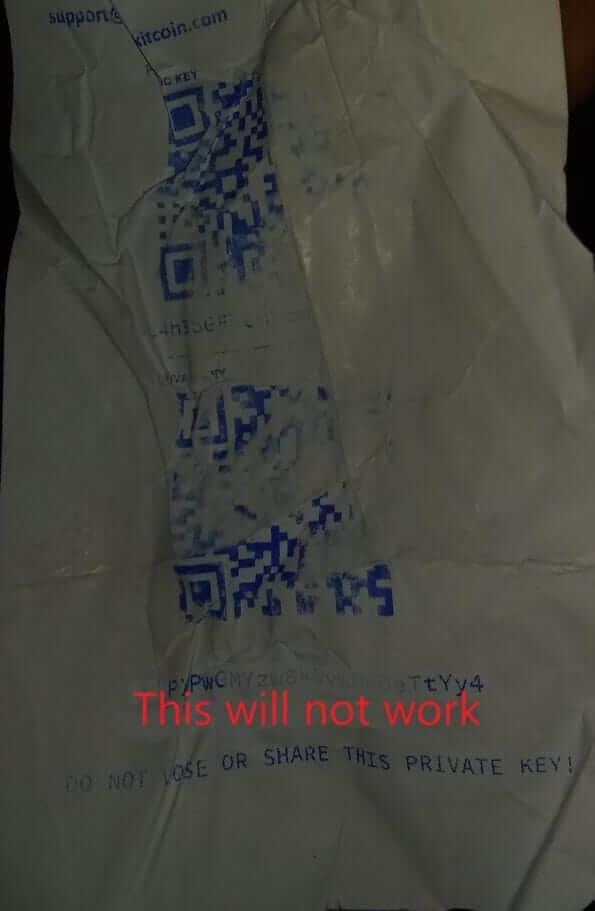
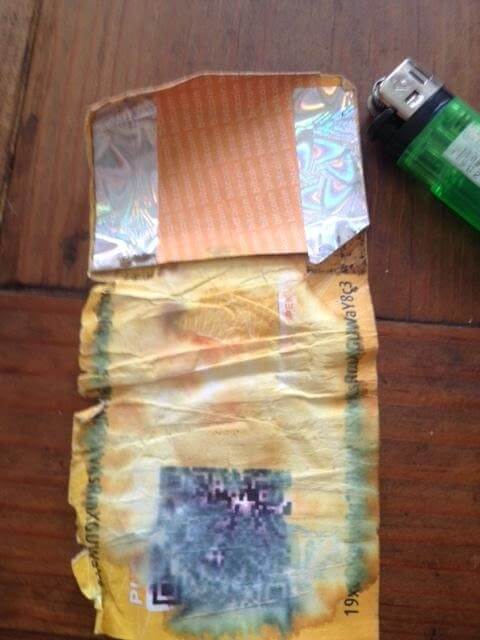
Pros and Cons of a Paper Wallet
Advantages:
- Immune to cyberattacks and malware as long as the private key has never been exposed online.
- Cheap, quick, and easy to generate.
- Can be used to gift Bitcoin, though Opendime and gift cards like Azteco and Bitrefill are now better options.
Disadvantages:
- Vulnerable to physical damage (water, fire) and loss. If you lose your paper wallet and have no backup, you’ll lose your funds.
- “Sweeping” the private key may be less intuitive for beginners.
- Used only once.
Why We Don’t Recommend the Use of Paper Wallets
Paper wallets are a simple solution for storing Bitcoin. However, more modern and safer methods, like hardware wallets, have become the preference. Though they operate offline, just like paper wallets, they don’t have vulnerabilities typical of a physical document, such as the possibility of being destroyed.
For educational and experimental purposes, it can be interesting to explore this type of wallet to gain practical experience, but it is not a suitable choice for beginners or those looking to securely hold substantial Bitcoin balances for the long term.
For such purposes, the hardware wallets are the most suitable because, besides being safer, they have an intuitive design for handling and configuration, are constantly updated, and have less complex recovery mechanisms through the use of seeds.
If you want hands-on experience with Bitcoin wallets, from paper to mobile and cold wallets, enroll in our Bitcoin Starter course. You’ll gain access to numerous theoretical and practical lessons.
I hope this explanation has helped you understand the concept of the Bitcoin paper wallet. And if you liked it, share the article with friends!
Share on your social networks:

One of the leading Bitcoin educators in Brazil and the founder of Area Bitcoin, one of the largest Bitcoin schools in the world. She has participated in Bitcoin and Lightning developer seminars by Chaincode (NY) and is a regular speaker at Bitcoin conferences around the world, including Adopting Bitcoin, Satsconf, Bitcoin Atlantis, Surfin Bitcoin, and more.
Did you like this article? Consider buying us a cup of coffee so that we can keep writing new content! ☕




